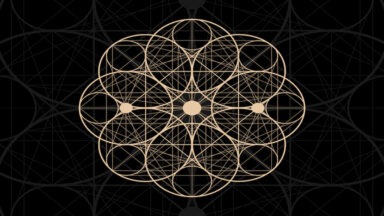Could Quantum Entanglement Explain Telepathic Communication?

A few years ago, an experiment allowed a test subject in India to communicate with someone in France without speaking or typing. Later that year, another group developed a telepathic interface that allowed two people to collaborate using their minds to play a video game. But these telepathic modalities for our tech gadgets seem analog compared to the psychic telepathy many of us experience at some point in our lives. Could quantum entanglement bridge the gap?
Telepathy Research
Brain-to-brain communication, or what most of us might call telepathy, is currently being developed to build more advanced, convenient interfaces for technology we use today. Though it’s pretty slow at the moment, these interfaces may soon be used to telepathically manipulate wireless devices, control prosthetics, and communicate in new ways.
Our brains are an intricate network of neurons and synapses transmitting electrical signals that become memories, commands, and ideas. And when these neurons transmit data back and forth, they in turn create brain waves, or synchronous oscillations that aggregate and transfer information across different segments of the brain.
Today, those brain waves can be externally translated through the use of electroencephalography, or an EEG cap. These swim caps dotted with electrodes continuously measure the brain’s electric signals in different regions, translating them to data that can pinpoint where in the brain those signals are coming from and what their general intentions are.
In a 2014 experiment, researchers made a breakthrough with a new interface that allowed signals from an individual’s brain to manipulate a robotic exoskeleton, allowing a once-paralyzed man to deliver the opening kick at the World Cup. Scientists involved in these experiments believe they portend a future in which this technology becomes so common, that we will surf the internet and manipulate our devices using thought alone.
So, Does Telepathy Exist?
In this sense, telepathic communication has essentially been proven possible, but what about the type of telepathic phenomena we experience naturally? Most people have experienced some type of uncanny ESP, whether it comes in the form of precognition, clairvoyance, intuition, or remote projection.
But if this phenomenon was measured in the way that brain interfaces work, we would expect to see things like a decay of the brain wave signal over long distances, or interference from other brain wave emissions. Instead, when we experience ESP phenomena, it seems impervious to these things. But, why?
Rupert Sheldrake’s theory of morphic resonance proposes an idea whereby all self-organizing systems in nature tap into a sort of collective memory that is not stored in the brain. Instead, this inherited memory exists psychically and can be accessed without regard to distance.
One aspect of this concept is that memory is passed down through genetics, but not in the sense that the information is written in to our DNA. To the contrary, Sheldrake provides the example of the failure of the Human Genome Project, which was unable to predict whether disease or physical attributes would be passed down based on one’s DNA.
Even for something as simple as height, it turned out that the information gleaned from genetic sequencing provided only five percent confidence in predicting the height of subjects’ progeny, compared to 80 percent confidence in simply measuring the parents’ height.
Instead, this collective memory seems to be passed on within groups of the same species that coexist together, and the more tight-knit a group is, the stronger a psychic bond exists.
In nature, this can be seen in the flocking behavior of birds or fish. When these animals swarm in schools or murmurations they change directions sharply without running into each other. This hive mindset is something unexplained by science, while evidence of some type of telepathic communication may be likely.
But what is the mechanism behind all this? Could it be explained by quantum theory?
The Possible Quantum Explanation
Physicists aren’t fond of what’s becoming a hackneyed theory that there may be a link between quantum physics and our consciousness; nonetheless there seems to be increasing evidence of a connection.
Einstein wasn’t the biggest fan of quantum entanglement, dismissing it as “spooky action at a distance,” because it didn’t fit into his general theory of relativity. But quantum entanglement is now a proven concept being used for quantum computing, and some physicists believe it could play a role in our consciousness.
Sir Roger Penrose first proposed the idea of a connection between quantum processes and consciousness, and he was quickly ostracized for it. The idea was considered sacrilegious to his materialist colleagues, who believed consciousness to be a physical product of the brain.
However, there has been another wave of acceptance for this theory supported by the research of esteemed U.C. Santa Barbara physicist Matthew Fischer. His theory came to him while he was recovering from depression.
Fischer was prescribed antidepressants finding them highly effective and able to lift him out of his slump. But he was astounded to learn that modern medicine doesn’t really have any idea why anti-depressants work the way they do to affect brain function.
Fischer did some research and found an experiment in which scientists gave mice two different isotopes of lithium and observed their behavior. He found that the mice given lithium-6 showed stronger maternal behaviors compared to those given lithium-7. The only difference between the two ions? Nuclear spin.
Nuclear spin determines how long an atom can remain in an entangled state, or how long it remains coherent. With lower spins, the nucleus of the atom interacts with electric and magnetic fields less, slowing its decoherence. In the mice’s brain, the lithium-7 with a higher spin would decohere too quickly, but the lithium-6 worked, despite just a one neutron difference in weight.
This led Fischer to the idea that lithium might interact with the brain through quantum entanglement – for particular chemicals, the spin needs to be just right to entangle with neurons in the brain. This had the profound implication that our cognition may involve quantum processes.
Dean Radin is one of the most notable names studying what he calls “entangled minds.” Radin is the Chief Scientist at the Institute of Noetic Sciences and has devoted much of his career to studying psychic phenomena, under the premise that quantum entanglement may bridge the gap between a seemingly paranormal function and provable science.
Radin says that based on 17th century science, or Newtonian physics, it’s easy to consider telepathy and psychic phenomena as paranormal, but now that quantum entanglement has been proven, and separate objects can be connected at great distances, psi could potentially become a replicable, natural function.
In this regard, it may be possible that the universe itself could be a single, self-entangled object and so could our brains. And if quantum physics is able to prove this, it just might change our entire conception of reality and consciousness itself.
Watch Regina Meredith’s interview with Dean Radin below:
What Is Automatic Writing and How to Use It for Channeling

Automatic writing is a technique used to access information from the unconscious or the spiritual plane through spontaneous writing. This practice allows for receiving messages that do not come from conscious thought, but instead manifest through the free flow of words onto paper. In this article, we explore what automatic writing is, its connection with spiritual channeling, and how you can begin practicing it step by step.
Table of Contents
- What Is Automatic Writing?
- Automatic Writing and Spiritual Channeling
- How to Practice Automatic Writing Step by Step
- Where Do Channeled Messages Come From?
- Spiritual Benefits of Automatic Writing
What Is Automatic Writing?
Automatic writing is a method of expression that allows the hand to write without the conscious intervention of rational thought. In this state, words emerge spontaneously, as if guided by an external source or an inner wisdom that manifests without mental filters. This technique has been used for centuries as a way to access content from the deep unconscious or as a tool for spiritual connection.
Many people who practice automatic writing report feeling that the messages do not come from themselves, but from other entities, energies, or planes of consciousness. The experience can vary: some people receive short phrases, others write entire pages, but in all cases, it’s about letting the body express itself without rational control. For this reason, the practice requires a state of relaxation and openness, without expectations or judgment about what appears on the page.
Automatic Writing and Spiritual Channeling
Automatic writing can also become a direct channel of communication with spiritual guides, interdimensional beings, or the higher self. In these cases, the person acts as a bridge between realms, allowing the message to be captured in words without the ego interfering in the process. This practice is considered a form of channeling when the message comes from a clear and coherent spiritual source.
In the series Channeling: A Bridge to the Beyond, available on Gaia, the various ways in which channelers access non-physical information are explored, including automatic writing as a tool to transmit messages from beyond. The series presents real experiences and testimonials from experts who explain how these practices help open consciousness and access transformative information.
How to Practice Automatic Writing Step by Step
Practicing automatic writing requires creating an adequate space, relaxing the mind, and allowing the words to flow without conscious control. It is not about writing from logical thought, but rather about opening up to a receptive state where information arrives effortlessly. With regular practice, this process becomes more fluid and clear.
Energetic Preparation and Inner Disposition
Before starting, it is essential to prepare the space and personal energy. Find a quiet place, turn off distractions, and create a harmonious atmosphere with soft lighting, incense, or gentle music if you prefer. Breathe deeply for a few minutes and set your intention to open yourself to receiving information with clarity and respect.
It is also important to check your internal state. Automatic writing is not just a technique—it is an act of receptivity. That is why it is necessary to be calm and with a neutral attitude. If you are anxious, rushed, or have rigid expectations about what “should” appear, you are likely to interfere with the process. The key is to release mental control and trust whatever arises.
Techniques to Facilitate the Writing Flow
One very useful technique is to start by writing repetitive phrases, such as “I am ready to receive” or “I open myself to whatever comes.” This initial writing acts as a bridge between the conscious and receptive states, helping calm the mind and activate the flow. Often, after a few lines, the tone of the message shifts and begins to flow on its own.
Another technique is to write without lifting the pen from the paper for several minutes, without worrying about the meaning of the words. This helps overcome initial blockages and gives way to a more natural rhythm. It doesn’t matter if at first only random words or meaningless sentences appear. What matters is to keep the movement going and observe whether the content starts to become coherent without rational intervention.
Practical Exercises to Start Channeling
One initial exercise consists of formulating a clear question before writing. Then, take a deep breath, relax your body, and begin to write anything that comes up, without correcting or thinking about structure. When finished, read what you wrote without judgment. Over time, you’ll notice the answers start to show more coherence and depth.
Another useful exercise is to write after a brief guided meditation. Spend a few minutes calming your mind, focusing on your breath, and visualizing a soft light enveloping your hands. Then, begin writing without a defined topic and allow the words to emerge freely. This practice helps you enter a deeper receptive state and facilitates connection with subtle realms.

Where Do Channeled Messages Come From?
The messages received during automatic writing can have different origins, depending on the level of connection and the intention of the channeler. These sources usually belong to higher planes of consciousness and act as guides for personal and spiritual growth. Identifying their origin helps better understand the type of information received and its purpose.
- Spiritual Guides: These are beings of elevated consciousness who accompany the soul’s path. Messages from them often offer clear guidance, protection, and support in important decisions.
- Akashic Records: They contain the energetic memory of the soul and its journey through time. Through automatic writing, it is possible to access fragments of this information to gain guidance on life processes and spiritual evolution.
- Ascended Masters: These are beings who have reached a high level of consciousness and wisdom. Their messages provide deep teachings and tools for personal and spiritual transformation.
- Higher Self: This represents the highest and wisest aspect of one’s own being. This connection allows for receiving messages aligned with life purpose and a deeper understanding of one’s path.
- Angels or Archangels: These are light energies that transmit peace, guidance, and assistance during times of change or difficulty. Often, channeled messages from these planes carry a loving, protective, and compassionate tone.
- Deceased Loved Ones: In some cases, the messages come from family members or close individuals who have passed on. These communications usually hold significant emotional value and can bring comfort or closure to unresolved matters.
Spiritual Benefits of Automatic Writing
Automatic writing is not only a tool for channeling information—it also supports spiritual growth by deepening inner connection, expanding perception, and cultivating greater emotional and energetic clarity. Its regular practice transforms the relationship with oneself and with what lies beyond the visible.
- Inner clarity: Helps identify thoughts and emotions that were hidden. This allows for more conscious and aligned decision-making.
- Connection with subtle planes: Facilitates access to higher levels of consciousness. This openness strengthens intuition and spiritual confidence.
- Emotional healing: Writing without filters allows the release of blockages and retained emotions. The process acts as a form of energetic cleansing and self-exploration.
- Development of intuition: Enhances the ability to perceive internal and external signals. This strengthens spiritual discernment in everyday life.
- Deep self-knowledge: When channeling messages, unconscious aspects of the self often emerge. This supports processes of personal transformation and expansion of consciousness.





































